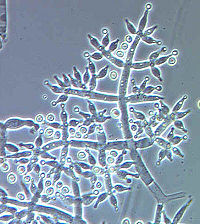
Photo from wikipedia
Advances in biocontrol potentials and fungicide resistance are highly desirable for Trichoderma. Thus, it is profitable to use mutagenic agents to develop superior strains with enhanced biocontrol properties and fungicide… Click to show full abstract
Advances in biocontrol potentials and fungicide resistance are highly desirable for Trichoderma. Thus, it is profitable to use mutagenic agents to develop superior strains with enhanced biocontrol properties and fungicide tolerance in Trichoderma. This study investigates the N-methyl-n-nitro-N-nitrosoguanidine (NTG) (100 mg/L) induced mutants of Trichoderma asperellum. Six NTG (3 each from 1st & 2nd round) induced mutants were developed and evaluated their biocontrol activities and carbendazim tolerance. Among the mutant N2-3, N2-1, N1 and N2-2 gave the best antagonistic and volatile metabolite activities on inhibition of chickpea F. oxysporum f. sp. ciceri, B. cinerea and R. bataticola mycelium under in vitro condition. Mutant N2-2 (5626.40 μg/ml) showed the highest EC50 value against carbendazim followed by N2-3 (206.36 μg/ml) and N2-1 (16.41 μg/ml); and succeeded to sporulate even at 2000 μg/ml of carbendazim. The biocontrol activity of N2-2 and N2 with half-dose of carbendazim was evaluated on chickpea dry root rot under controlled environment. Disease reduction and progress of the dry root rot was extremely low in T7 (N2-2 + with half-dose of carbendazim) treatment. Further, carbendazim resistant mutants demonstrated mutation in tub2 gene of β-tubulin family which was suggested through the 37 and 183 residue changes in the superimposed protein structures encoded by tub2 gene in N2 and N2-2 with WT respectively. This study conclusively implies that the enhanced carbendazim tolerance in N2-2 mutant did not affect the mycoparasitism and plant growth activity of Trichoderma. These mutants were as good as the wild-type with respect to all inherent attributes.
Journal Title: PLOS ONE
Year Published: 2023
Link to full text (if available)
Share on Social Media: Sign Up to like & get
recommendations!